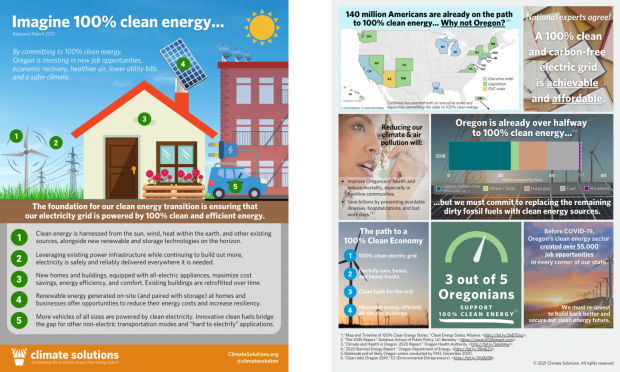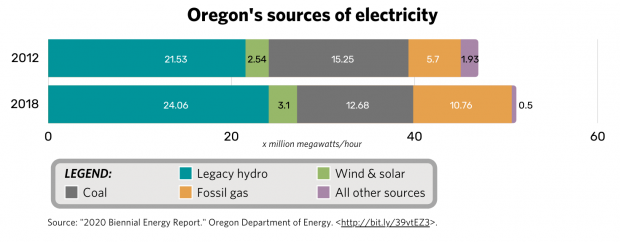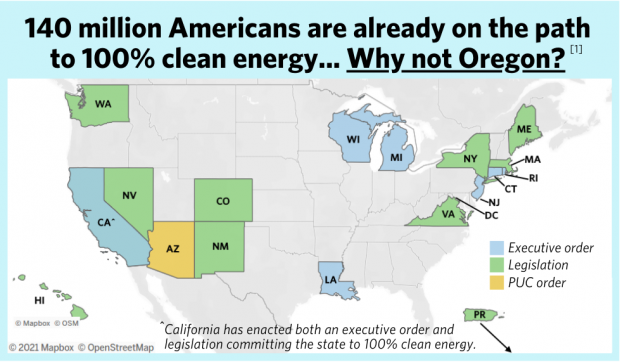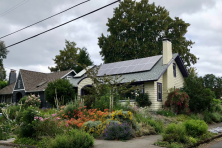Growing up in Salem, Oregon, I can confirm the gold pioneer statue atop the Oregon State Capitol has the best view in town. Affectionately known to Salemites as “the Gold Man”, this familiar figure has inspired numerous local business logos, teenage garage band names, and even kids’ Halloween costumes over the years. Given this rich lineage, it has been particularly distressing to see the Gold Man at the center of so many searing images capturing the climate-fueled disasters recently devastating our beautiful state.
In just the past year, the Gold Man has gazed solemnly as Oregon’s skies glowed an eerie red from deadly climate-fueled wildfires raging nearby and then as the landscape froze solid from ice storms of unprecedented size and destruction. He’s also witnessed democratic norms melting down as walkouts blocked a major climate action bill that would have helped reduce future harm.
The relentless ice storms over the 2021 President’s Day weekend knocked over giant trees and electric wires, and resulted in gas leaks and the largest power outage in state history. Utility crews braved the treacherous weather, scrambling to restore power as many of us were without lights and heat for a week or longer. Experts have highlighted the clear climate nexus with this series of storms: in February, a weakening jet stream drove arctic temperatures down through Oregon all the way to Texas—while it was 18 degrees above normal in Greenland.
Whether Oregon families were fleeing toxic wildfire smoke or darkened ice-bound homes, the ongoing COVID-19 pandemic added another layer of complexity to each crisis. Frankly, over the past year, Oregonians have dealt with enough historic weather events to last us a lifetime, never mind amidst a global pandemic. But given the worsening climate crisis coupled with a lack of commensurate response from our state, these trials by fire and ice aren’t likely to relent anytime soon. These climate disasters have also demonstrated that our electric grid needs to be smarter and more resilient to survive extreme weather, and must rely on abundant clean, renewable sources of energy that do not add more fuel to the fire of climate chaos.
HANDOUT: Imagine 100% Clean Energy for Oregon
This handout demonstrates how a 100% clean energy grid works from a citizens' perspective and explains how a statewide commitment to 100% clean energy would work together with other existing climate and clean air policies—like the Oregon Climate Action Plan, Clean Fuels Program, and federal laws and regulations—to help us achieve our carbon pollution reduction goals while ensuring our energy needs are met for decades to come.
100% clean energy is urgently needed
Despite all our work to date to clean up our electrical grid, Oregon still gets half its power from fossil fuels and is currently projected to become the dirtiest energy grid on the West Coast.
Washington and California have enacted laws putting them on track to 100% clean energy by 2045, but we have not. Thanks to Oregon’s Coal to Clean law (passed in 2016), dirty coal plants will be phased out as an energy source for Oregon’s electric grid by 2030. However, so far, retiring coal plants have been largely replaced by increasing our state's reliance on fossil gas power plants. The amount of fossil gas in Oregon’s electricity resource mix doubled between 2012 and 2018 as coal retired, according to the Oregon Department of Energy. Fossil gas use is now the second-largest source of greenhouse gas pollution in Oregon (22%)—we currently use the primarily-fracked gas for generating electricity, heating buildings and industrial processes.
To chart a better course for Oregon, we need a new 'north star' of 100% clean energy. Our electric system cannot continue to rely on uncontrolled fossil gas. A 100% Clean policy (HB 2021) will enable us to rapidly shift our electric mix from fossil fuel reliance to being powered entirely by affordable, non-polluting sources like solar, wind, and innovative energy storage technologies by the year 2040. With targets along the way, HB 2021 will ensure our utilities are rapidly decarbonizing, achieving 80% clean by 2030, 90% clean by 2035, and 100% clean by 2040. The bill also draws a line in the sand on fossil fuels for powering our state, not permitting any more new fossil gas plants to be built in Oregon.
100% clean energy is the foundation to a clean economy
Not only is it possible, 100% Clean Electricity policy is also mission critical to deeply decarbonize Oregon’s economy. Numerous studies covering different geographies (including the Pacific Northwest) have all reached a similar conclusion: in order to achieve meaningful economy-wide greenhouse gas emissions reductions, the electricity sector must approach zero emissions. A zero-emission electric sector will serve as the clean energy backbone to power our buildings, transportation, and industries.
When Climate Solutions studied the pathways to reaching our climate goals in the transportation sector, we found that Oregon cannot meet them without a zero carbon grid. The transportation sector is Oregon’s biggest source of climate pollution. Air pollution from this sector disproportionately harms low-income and Black, Indigenous and People of Color (BIPOC) communities living near highways, ports and other pollution hot spots first and worst. We must rapidly electrify our transportation sector (along with increasing transit, walking and biking choices) in order to achieve our climate goals and improve public health for all Oregonians. However, we will fall short if we just swap fossil fuels like gas and diesel for a fossil-heavy grid. A 100% Clean policy ensures that the electricity fueling our vehicles comes from renewable sources. 100% clean electricity, paired with electrifying everything from cars and delivery trucks to homes and buildings, will lead to better air quality and health, reduce how much money we spend for our power and getting around, and address Oregon’s share of the pollution fueling the climate crisis.
Research confirms that the transition to a fossil-free grid can be affordable and feasible with technologies that exist today. Statewide commitments to attain 100% Clean Energy are neither a new nor revolutionary concept at this point either. Eight US states have already adopted 100% clean electricity policies, including our West Coast neighbors to the north and south. Oregon is ready to transition off dirty fossil fuels like coal and fossil gas, to clean, affordable, reliable energy sources like wind and solar. If designed well, we will create good paying jobs, protect our health and climate, and re-establish Oregon as a leader in renewable energy innovation.
100% clean energy creates jobs
In 2019, Oregon’s clean energy sector created over 55,000 job opportunities in every corner of our state. Clean energy industries have not been exempt from the effects of the ongoing COVID-19 pandemic as this report by E2 and Oregon Business for Climate makes clear. However, as our country steers toward a post-COVID-19 economic recovery, we have a critical opportunity to add thousands of family-wage jobs, address the worsening climate crisis, and kickstart our just transition to a clean energy future—by investing in the clean energy sector. The renewable energy market has grown steadily in the past decade, and more industry experts and financial advisors than ever are pointing to the writing on the wall: renewables—not fossil fuels—are the sure-bet energy investment of the future. Oregon should be doubling down on its commitment to clean energy technologies, and pairing it with a prevailing wage and benefits for the workers who are making our clean energy future a reality.
100% clean energy strengthens communities
With the COVID-19 pandemic, devastating wildfires, and widespread unemployment, there’s never been a more important time for energy policy that helps Oregonians recover and build back even stronger than before. 100% clean energy can create economic opportunities in communities across Oregon. Importantly, HB 2021 focuses on how Oregon’s transition to 100% clean energy should maximize economic opportunities and benefits for environmental justice communities. This means investing in rural and low-income communities, BIPOC communities, and Tribal Nations. Incentivizing community-based projects like on-site solar paired with storage and microgrids will increase energy independence, affordability, and disaster resilience across Oregon. Passing 100% Clean (HB 2021) this year along with the Energy Affordability bill (HB 2475) means low income families could see reduced energy bills and our state’s transition to clean energy will be more equitable.
100% clean energy can be our reality
We can start reducing our climate pollution while investing in communities across Oregon this legislative session. One of the foundational policies that will set Oregon on a cleaner, more resilient path is 100% Clean Energy for All (HB 2021). This is a critical priority bill for us and the Oregon Clean Energy Opportunity coalition, a broad group of Oregon nonprofits and community groups (of which Climate Solutions is a member). It will also allow us to continue to retool our energy infrastructure to deliver the cleaner air, energy independence, and community resilience Oregonians deserve. All this while , while spurring economic development and creating family-wage jobs across the state for clean energy, storage, and transmission projects.
As we advocate for policies like 100% Clean Energy, I can hope we’re giving the Gold Man a better view of tomorrow and future generations: clearer skies, better economic and job opportunities, more resilient communities, and equitable policies that protect Oregon’s special places and all of the people who call this magnificent state home. Let’s make that view our reality.








